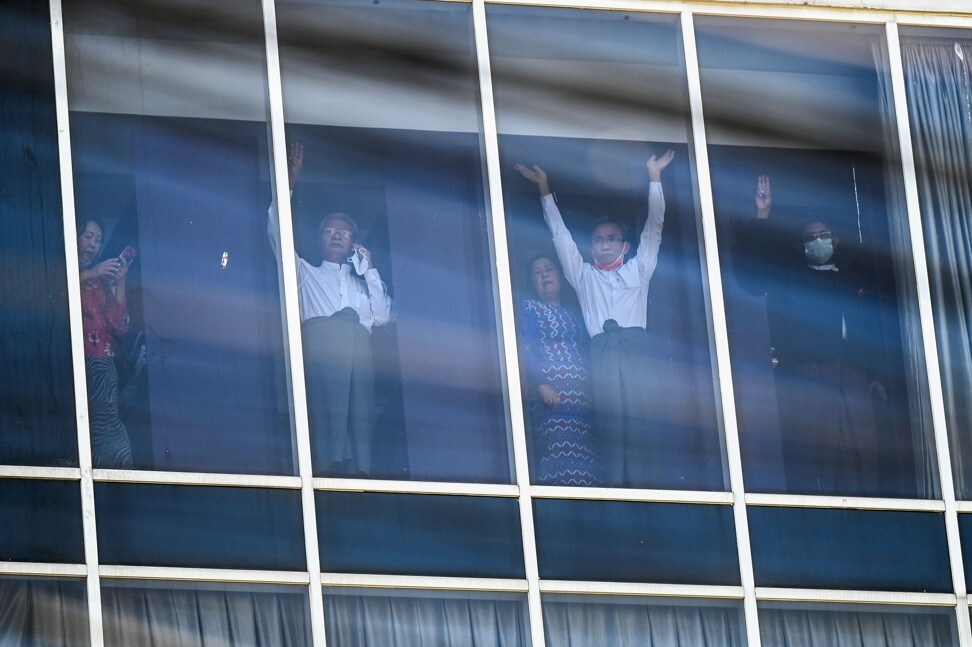
01:37
Myanmar coup: junta cuts internet as troops open fire to break up protest

The following is a two-week timeline of events since Myanmar’s military took power in a coup on Monday, February 1, starting from when civilian leader Aung San Suu Kyi was detained by the Myanmar military and a state of emergency declared in the country.
February 1: Aung San Suu Kyi, President Win Myint and other senior figures from the National League for Democracy (NLD) are detained in an early morning raid.
The military declares a state of emergency for a year, and says it carried out the detentions in response to alleged election fraud, handing power to army chief Min Aung Hlaing.
The NLD publishes a statement on behalf of Suu Kyi written before she was detained, urging people to protest the military coup.
The junta removes 24 ministers and deputies, naming 11 replacements.
February 2: Min Aung Hlaing tells the first meeting of his new government it was inevitable the army would have to take power after its protests over alleged election fraud.
Vehicle horns and pans being struck are heard around Yangon after dark in protest against the coup.
Facebook removes a page linked to Myanmar’s military-owned TV network in a measure to protect against harm, according to a spokeswoman.

01:37
Myanmar coup: junta cuts internet as troops open fire to break up protest
February 3: Staff at 70 hospitals and medical departments across Myanmar stop work to protest against the coup. Others wear red ribbons as part of a civil-disobedience campaign.
The NLD’s offices in several regions of the country are raided, with documents, computers and laptops taken.
Myanmar police file charges against Suu Kyi and seek her detention until February 15. A police document says military officers who searched Suu Kyi’s residence found six handheld radios that were imported illegally and used without permission.
Charges are also filed against President Win Myint over violating protocols to stop the spread of the coronavirus.
Government orders blockage on Facebook, as well as its Messenger and WhatsApp services, for the sake of “stability”.
February 4: A group of protesters wave banners and chant anti-coup slogans in Mandalay in the first such street protest against the army takeover. At least three are arrested.
The United Nations Security Council calls for the release of Suu Kyi and others detained by the military, but stops short of condemning the coup.

In his first foreign policy address, US President Joe Biden says Myanmar’s military should relinquish power and release officials and activists.
Another leading figure in Aung San Suu Kyi’s National League for Democracy party, Win Htein, 79, is arrested.
February 5: Teachers and some government workers join the civil disobedience movement, saying they will not work for the authorities unless the elected government is restored.
Aung San Suu Kyi’s lawyer says he has been unable to meet her because she is still being questioned. He calls for the immediate release of her and President Win Myint.
Japanese beverage group Kirin Holdings says it is terminating its alliance with Myanmar Economic Holdings Public Company (MEHL), which has links to the military.
February 6: Blockages are ordered on Twitter and Instagram, where protesters had been sharing information. The junta then ordered the country’s internet shut down.
Tens of thousands of people take to the streets to protest against the coup in Yangon and other cities.
February 7: Protests sweep Myanmar, with tens of thousands in Yangon and elsewhere in the biggest show of mass anger since the 2007 protests that helped lead to democratic reforms.
Internet access is restored, but social media platforms remain blocked.
February 9: Police fire guns mostly into the air, and used water cannons and rubber bullets to try to clear protesters in the capital Naypyidaw. One woman shot in the head with live bullet is not expected to survive, a doctor said.
February 11: The United States imposes sanctions on Myanmar’s acting president and several other military officers and warned the generals there could be more economic punishment over the coup.

February 12: Hundreds of thousands join nationwide pro-democracy demonstrations, with three people wounded by rubber bullets in clashes with police. Social media giant Facebook said it would cut the visibility of content run by Myanmar’s military, saying they had “continued to spread misinformation” after seizing power.
February 13: The junta suspends laws constraining security forces from detaining suspects or searching private property without court approval and orders the arrest of well-known backers of mass protests.
February 14: The civil disobedience movement spreads, disrupting air and train travel. Police open fire to disperse protesters at a power plant further arrests made.
February 15: Armoured vehicles are deployed in major cities and internet access is blocked on the day Suu Kyi’s detention period was supposed to end. But Myanmar’s military leaders extended her detention until Wednesday, when she is likely to appear in court by videoconference.